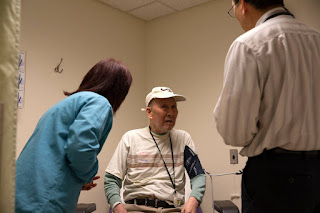Lourdes Cerna, 58, goes to her desk in the living room at 5 am with a hot mug of tea. She lives in Los Angeles. As soon as she logs in, the calls start. That day, the first call is from Texas. The doctor on the other side speaks about the lady patient who is struggling to breathe.
Please tell her if she doesn’t agree to go on a ventilator,
she will not survive the day, says the doctor. Cerna faithfully translates it
in Spanish. You may use your own words, the doctor says. Cerna asks the lady
about her family, and tells her that her grandchildren will be happy to see her
back. The lady is determined. This is the end; she doesn’t wish to go back.
Cerna says bye to her, translates everything to the doctor. Moves to the next
call in line.
Cerna is a professional medical interpreter. Before the pandemic, she would be in the hospital
room talking face-to-face with a patient. She misses it now. But for a whole
year, she has been working fifteen hours a day. USA’s different time zones make
the working day longer. For many patients, she was the last person they spoke to.
She also often needed to call the relatives to deliver the worst possible news.
Professional interpreters are expected to do their job
keeping emotions aside. But Cerna has a handkerchief and a bottle of solution
to clean her glasses next to the computer. There have been dozens of days at
the end of which she sat there drained, crying alone.
*****
Dr Alister Martin faced his patient, a Hispanic man
who spoke no English. Speaking clearly, he told him he would be intubated. He
asked the patient, a bus driver and a father of three, to call his wife, give
her his love and say goodbye. Then Dr Martin held the phone closer to the
patient’s ear. The interpreter translated everything Dr Martin had just said.
At the Boston hospital, the quality of care for
non-English speaking patients has deteriorated. “Someone’s oxygen is dropping,
I have to get an interpreter on the phone, put in an access code, tell them
where I am.” Dr Martin said. “It’s hard for the patient. Imagine you’re in a
loud room with a mask blowing oxygen in your face at fifteen liters a minute
and you feel crummy. You can’t comprehend things much.”
Normally, non-English speakers have some family
members who can speak English. They hold hands, help with translation. But in
covid times, family visits are barred.
*****
In nations with a single language, this problem rarely
arises. But in countries such as the USA or Canada or Australia, with a large
number of immigrants, not having a common language with the doctor or nurse can
spell the difference between life and death. USA has 65 million people who
speak limited English. The language discordance undermines communication and
trust, and leads to suboptimal care, less understanding of the diseases and
treatments, and difficulties in joint decision making. Patients end up staying
longer at the hospital, and more likely to return there.
In a detailed study one hospital found something
shocking. Even among the Hispanic covid patients, those speaking only Spanish
had a 35% greater risk of death.
*****
USA has a legal requirement to have medical
interpreters. But it is what is called an “unfunded mandate”. The certification
is not strict, and remuneration is not specified. Once the pandemic began, the
role of medical interpreters was so underestimated that initially no PPEs were
ordered for them. Many of them now work from home, like Lourdes Cerna does. It’s
not easy, because many patients are breathing with effort, coughing or their
voices are muffled. Richer hospitals are trying to get i-pads and microphones
for the patients. Some hospitals are consciously employing Spanish speaking
doctors to attach to each medical team.
The relatively lucky patients speak their last words to
the interpreter on an i-pad in their own language before dying. Others who have
no common language with the attending doctors die silently.
Ravi

आपल्याकडे ही दुखःद परिस्थिती नाही
ReplyDeleteAnother important role, I wasn't aware of...
ReplyDelete